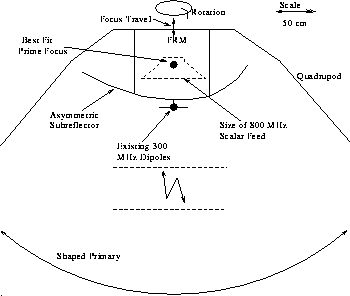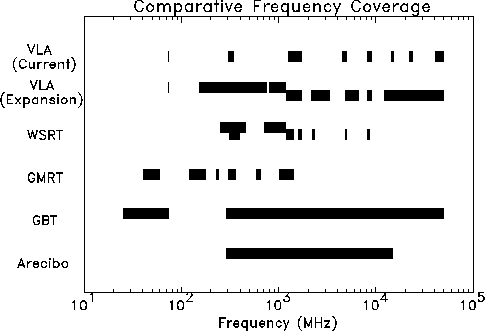
Figure 5.2: A sketch, approximately to scale, of the prime focus region of the VLA antenna.

Figure 5.2: A sketch, approximately to scale, of the prime focus region of
the VLA antenna.
To observe at frequencies above  400 MHz requires modifying
the quadrupod and focus-rotation mount (FRM) if high performance is
desired. The reason for this is illustrated in Fig. 5.2
which shows that the subreflector support structure currently blocks
the prime focus. Obtaining access to the prime focus by retracting the
subreflector requires lengthening the legs of the quadrupod. The FRM
must then be modified to position the subreflector to illuminate the
Cassegrain feeds optimally. The only way to avoid this with the
present subreflector is to accept the poor beam shape and
reduced aperture efficiency associated with operating the feed
at an out-of-focus position, as we do now.
400 MHz requires modifying
the quadrupod and focus-rotation mount (FRM) if high performance is
desired. The reason for this is illustrated in Fig. 5.2
which shows that the subreflector support structure currently blocks
the prime focus. Obtaining access to the prime focus by retracting the
subreflector requires lengthening the legs of the quadrupod. The FRM
must then be modified to position the subreflector to illuminate the
Cassegrain feeds optimally. The only way to avoid this with the
present subreflector is to accept the poor beam shape and
reduced aperture efficiency associated with operating the feed
at an out-of-focus position, as we do now.
Other options that might be considered to expose the prime focus include shifting the subreflector laterally, tilting it to one side; or, if the subreflector is rebuilt, having it open like a clam shell. (The last approach may be the only practical way to operate at the prime focus if a larger subreflector is used to extend the 1.4 GHz band down to 1.2 GHz.)
The 800-1200 MHz system may be the most problematic. Because of the size of the feed, it must be located at the prime focus. Design of an efficient feed at the prime focus is hampered by the shaping of the primary reflector (which departs from a true paraboloid by about 1 cm, so there is no exact prime focus). To avoid interfering with observations in other bands, the feed must be removable. One idea is to stow a scalar feed against one leg of the quadrupod, swinging it into place when needed. There are concerns, however, about the mechanical complexity and maintenance of such a system.
Another concern is that prime focus systems are somewhat more susceptible than Cassegrain systems to interference from low-elevation sources. This may become more important in the presence of an ever-worsening RFI environment (see §5.6).

Figure 5.3: The frequency coverage of large interferometer arrays and
single dishes compared with the current VLA and with the proposed VLA
enhancements.
At issue is which options offer the best scientific return without seriously compromising the performance at other frequencies. The present 75 MHz and 327 MHZ feeds may raise the system temperature at L Band by about 10% (the magnitude of the effect is not well-determined). This effect may be present for the proposed prime focus systems at all bands, and is likely to depend on frequency in a complex manner.
A related issue is whether to pursue high-efficiency performance at the prime focus at all. Fig. 5.3 compares the proposed enhanced frequency coverage for the VLA with that of other large interferometers and single dishes. The GMRT in India, and the WSRT in the Netherlands, will provide coverage in the frequency bands of interest, albeit with reduced sensitivity or narrower bandwidths. The GBT and Arecibo will provide a single dish capability over the frequency range of interest with good sensitivity.
An alternative to prime focus operation at the VLA may be to build inexpensive wide-band antennas (e.g., log-periodic arrays) to support some low frequencies separately. Such a stand-alone antenna system, sharing access to the I.F. transmission system and the correlator for simultaneous observations with the VLA paraboloids, has previously been proposed for 74 MHz. It may be appropriate to identify what range of observing frequencies could be better served by such an array than by working at the prime focus, and at what cost. For 74 MHz, antenna tolerances can be met cheaply because the wavelength is so long (4 m). At higher frequencies, more costly and more numerous antennas would be needed to sample the shorter u-v spacings (or the antennas would need to be transportable). The cost and effectiveness of such options (as a function of frequency) should be weighed against that of prime focus operation, but it seems unlikely that that they would help the most difficult (800-1200 MHz) case at reasonable cost.
The difficulties of operating prime focus systems between a few hundred and 1200 MHz without degrading the Cassegrain performance emphasize the need for knowing more about VLA's RFI environment (see §5.6). Improved RFI statistics might help to define the most appropriate band edges.